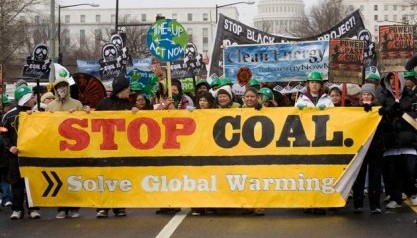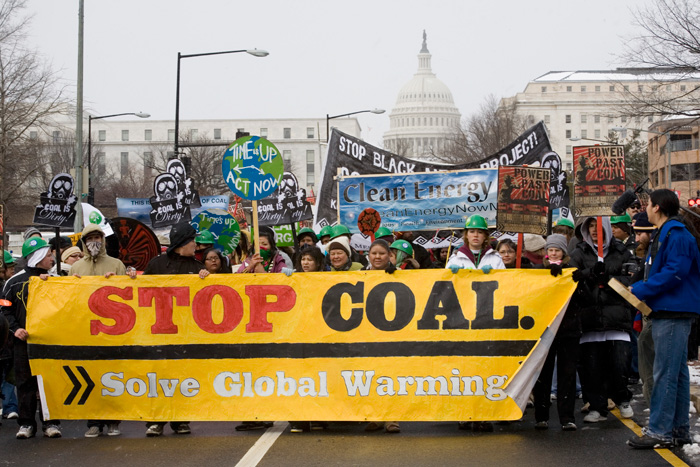 Down with coal!The climate fight hasn’t been going well lately. The Copenhagen conference in Dec. 2009 seemed to mark the effective end of international efforts to control carbon. The U.S. Senate couldn’t even bring itself to vote on cap-and-trade last summer. In November, a GOP committed to climate denial won new strength in the Congress. Right now, the House is busy trying to strip the EPA of the right to regulate greenhouse gas emissions. Oh, and 2010 was the warmest year on record.
Down with coal!The climate fight hasn’t been going well lately. The Copenhagen conference in Dec. 2009 seemed to mark the effective end of international efforts to control carbon. The U.S. Senate couldn’t even bring itself to vote on cap-and-trade last summer. In November, a GOP committed to climate denial won new strength in the Congress. Right now, the House is busy trying to strip the EPA of the right to regulate greenhouse gas emissions. Oh, and 2010 was the warmest year on record.
But there is one fight that’s gone very much the right way, and it holds lessons for the future. In 2006, about 150 new coal-fired power plants were in some stage of the planning process around the United States. But thanks to truly splendid organizing, ground has been broken on but a handful of those projects — more than a hundred have disappeared.
Much of the credit for those victories has gone, appropriately, to the Sierra Club — its National Coal Campaign, led by Bruce Nilles, took careful advantage of the group’s deep legal and organizational resources, especially a chapter structure that meant they had experienced people in many of the spots where those new plants were slated. It was work that would have made John Muir or David Brower proud. Nilles’s motto was “Leave no coal plant behind,” and over the last five years he’s surprised many a utility executive who expected little opposition.
But the Club had plenty of help too, some of it from unusual places. A consortium of foundations led by the Rockefeller Family Fund helped provide not only resources for the fight but crucial coordination. By the summer of 2005, RFF’s Larry Shapiro, David Wooley from The Energy Foundation, Nilles, and others formed a loosely organized “coal cadre.”
The foundations came in with some sense of the outline of the fight — they were, after all, getting funding requests from scattered local groups that had sprung up in response to particular plants.
“I first went to Florida in 2005 to meet with several groups fighting coal plants,” said Shapiro. “I thought I would figure out who we could give $50,000 to. After my trip, I realized it wasn’t a $50,000 project — it was a million-dollar project. Over time, the Energy Foundation and others got into the game, so we ended up with some real money.”
Shapiro explained that getting the right partners was key: “I found some brilliant allies such as David Guest at Earthjustice in Tallahassee and Manley Fuller at the Florida Wildlife Federation. We put together a working coalition right before Charlie Crist was about to take office [as governor of Florida] in Jan. 2007. Within six months, things had completely turned around in Florida. Coal plants were canceled and Gov. Crist was well on his way to becoming a climate hero. (Of course, his work on climate may have been a large factor in his virtual expulsion from the Florida Republican Party. But that’s a story for another time.)”
As the campaign unfolded over the next few years, a loose geographic breakdown developed: The Sierra Club was strongest west of the Mississippi, while RFF and the Energy Foundation helped lead efforts in the East — especially the Southeast, one of the most coal-dependent (and politically difficult) regions of the country. The Energy Foundation found money for litigation, while RFF specialized in underwriting grassroots mobilization and education.
“There are lots of groups out there passionately engaged and close to the battlefront,” says RFF’s Lee Wasserman. “They often have capacity issues we can help with — and since we know all the other players, we can help coordinate.”
RFF also pioneered another useful tactic — one in keeping with its New York location. Sensing that the new plants were vulnerable not only on environmental but also fiscal grounds, the foundation launched the Power Plant Finance Project in the fall of 2007. New coal plants can cost $2 billion or more; the flow of capital from investors is as crucial as the flow of coal from the mines. The Finance Project has developed the data to show that fast-rising construction costs, regulatory uncertainties stemming from the chance of EPA or congressional action, and volatility in the global coal market make coal-fired plants risky gambles — not just for potential investors, but for ratepayers who are often left with the bill.
“RFF aims to help forge a broad potential consensus,” says Shapiro. “[The Finance Project] gives on-the-ground advocates another sophisticated tool.”
So by mid-2008, as local groups supported by RFF were working hard in South Carolina, Kentucky, Ohio, and Virginia, the foundation dispatched Finance Project personnel to help add new arguments to the arsenals.
All this activity is working. Last year, utilities announced plans to build 5,465 new megawatts of coal-fired power, but they also announced that more than twice that capacity — 13,000 megawatts — had been cancelled or delayed. RFF’s price tag for this work, between its own money and funds it has helped to leverage from other foundations: about $2.8 million. Which in one sense is a lot of money. And in another sense is about a thousandth of the price of a single new power plant.
But this hard-pressed and wearying battle has been the easy part of the job. Now the focus increasingly turns to existing coal-fired plants, already paid for and generating both electricity and profits. Turning them off will be crucial if the U.S. is to staunch the flow of carbon into the atmosphere. Activists will also need to disrupt coal producers’ plans to dramatically incrase exports to Asia, to make up for declining coal markets in the U.S.; new ports are being planned (and fought) up and down the West Coast.
And in those battles, the knowledge gained over the last half decade will be essential. In fact, RFF’s Heidi Binko is leading a group of anti-coal funders that held its third meeting this past fall in Chicago, and the foundation is working with veteran organizer Marshall Ganz to develop a broad citizen-engagement strategy.
“Our leadership on coal issues remains quiet,” says Shapiro. “I think that is partly why we are generally so well received, even to the point where many NGOs that deal with coal treat us as a colleague rather than with the deference they often reserve for funders.”
350.org, which was co-founded by Bill McKibben, has received funding from the Rockefeller Family Fund and has collaborated with the Sierra Club. Grist has also received funding from RFF.



